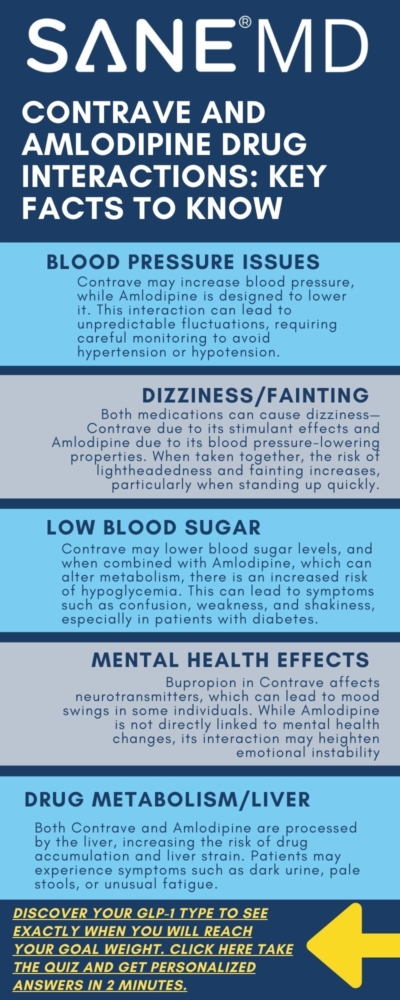Contrave and Amlodipine Drug Interactions: Key Facts to Know
Dr. Matthew Olesiak, MD, is the Chief Medical Director at SANESolution, a renowned wellness technology company dedicated to providing evidence-based solutions for optimal living. Dr. Olesiak earned his medical degree from the prestigious Jagiellonian University Medical College in Kraków, Poland, where he developed a strong foundation in medicine.

When considering prescription medications, understanding potential drug interactions is essential for safety and effectiveness.
Contrave, a combination drug used for weight loss, and Amlodipine, a common medication for high blood pressure, may interact in ways that affect patient outcomes. Knowing how these medications work together is key to minimizing increased risk of side effects and ensuring effective treatment.
This article explores Contrave and Amlodipine drug interactions, potential side effects, and what you should discuss with your healthcare professional before starting either medication. Our aim is to help you decide if Contrave is the best weight loss solution for you. Remember, if you take both, understanding how they interact can help manage conditions like high blood pressure and weight management safely.
Key Takeaways
- Contrave and Amlodipine may impact blood pressure regulation, requiring close monitoring by your healthcare professional.
- Taking Contrave while on Amlodipine could increase the risk of side effects, such as low blood sugar and mental health changes.
- Always talk with your doctor before adjusting medications to avoid serious allergic reactions or unintended complications.
Contrave and Amlodipine: Key Comparisons
| Factor | Contrave | Amlodipine |
|---|---|---|
| Drug Purpose | Weight loss | Blood pressure management |
| Active Ingredients | Bupropion, Naltrexone | Calcium channel blocker |
| Potential Interactions | Amlodipine, beta blockers, SSRIs, opioids | Contrave, beta blockers, grapefruit juice, alcohol |
| Effects on Blood Pressure | May increase blood pressure | Lowers blood pressure |
| Risk of Low Blood Sugar | Can lower blood sugar, caution with diabetes | Minimal impact on blood sugar |
| Mental Health Considerations | May increase suicidal thoughts, bipolar disorder risk | Not directly linked to mental health changes |
| Warnings & Precautions | Not for patients with eating disorders or opioid use | Avoid grapefruit juice; monitor for dizziness |
How Contrave and Amlodipine Work
Contrave: A Combination Drug for Weight Loss
Contrave is a combination drug that includes bupropion and naltrexone, two medications that work together to influence appetite, cravings, and metabolism.
It is prescribed as part of a weight management plan, typically alongside dietary changes and increased physical activity. But what does Contrave do?
Bupropion: A Dual-Purpose Medication
Bupropion is an extended-release tablet that was originally developed as an antidepressant under the brand name Wellbutrin XL. It belongs to a class of medications that affect mental health conditions by altering the levels of neurotransmitters such as dopamine and norepinephrine.
These neurotransmitters regulate mood, motivate, and reward-driven behaviors, which can influence eating behaviors.
In addition to treating depression and bipolar disorder, bupropion has also been used to assist smoking cessation, marketed as Zyban. The drug’s ability to modulate cravings and impulse control makes it useful for weight loss for certain individuals when combined with naltrexone.
Naltrexone: Opioid Receptor Modulator for Appetite Control
Naltrexone is traditionally used for opioid withdrawal and alcohol dependence, as it works by blocking opioid receptors in the brain. This action reduces the pleasurable effects of substances like alcohol and opioids, helping individuals manage cravings.
When used in Contrave treatment, naltrexone affects the brain’s hypothalamus, the region responsible for hunger and satiety. By modifying the brain’s reward system, naltrexone helps reduce food cravings and emotional eating, making it easier for compatible patients to adhere to a weight loss plan. Drinking alcohol while on Contrave may result in elevated anxiety and heightened agitation.
How Contrave Works for Weight Loss
The combination of bupropion and naltrexone influences both appetite regulation and cravings, creating a dual-action approach to weight management.
Studies have shown that Contrave for weight loss treatment can lead to significant weight loss for certain patients, particularly those with high blood pressure, certain mental health conditions, or metabolic disorders.
Patients taking Contrave should be aware of potential drug interactions and the risk of mental health changes, including suicidal thoughts, particularly in those with a history of bipolar disorder or depression. Side effects may also include low blood sugar, skin rash, and unusual tiredness. Common side effects of Contrave include nausea, constipation, and headache.
Contrave is not suitable for individuals with a history of eating disorders, such as anorexia or bulimia, due to the potential for adverse effects. In fact, healthcare professionals generally avoid prescribing Contrave to individuals with anorexia or bulimia.
Dr. Matthew Olesiak, MD, Chief Medical Director at SANE MD, advises:
“When combining medications like Contrave and Amlodipine, it’s important to track blood pressure changes and mental health status closely. Patients should work with their healthcare provider to adjust doses if necessary, ensuring that weight loss goals align with overall health.”
Amlodipine: A Blood Pressure Medication
Amlodipine is a calcium channel blocker that is widely prescribed for the treatment of high blood pressure and other cardiovascular conditions.
Unlike beta blockers, which primarily reduce heart rate, calcium channel blockers like amlodipine relax blood vessels and improve blood flow, reducing strain on the heart.
Uses of Amlodipine
Amlodipine is used to treat several cardiovascular conditions, including:
- High blood pressure (hypertension) – Amlodipine helps lower blood pressure by preventing calcium from entering muscle cells in the blood vessel walls, allowing them to relax. This improves circulation and decreases the risk of complications such as stroke, heart attack, and kidney disease.
- Amlodipine helps stabilize cardiovascular function in patients with severely high blood pressure (hypertensive crisis prevention).
- Angina (chest pain due to reduced blood flow to the heart) – Amlodipine can increase the risk of low blood pressure if combined with other antihypertensive drugs, requiring dose adjustments.
- Coronary artery disease (CAD) – It improves blood supply to the heart and reduces the frequency of angina episodes.
Potential Interactions and Side Effects
While effective for managing high blood pressure, amlodipine interactions with other medications, including Contrave, can lead to unwanted effects such as:
- Fluctuations in blood pressure
- Increased risk of dizziness and fainting
- Serious allergic reaction, including skin rash and swelling
- Dark urine or pale stools, indicating possible liver issues
- Mental health changes, particularly when combined with bupropion in Contrave treatment
Consuming alcohol while on Amlodipine can heighten the risk of experiencing low blood pressure. Additionally, individuals taking Amlodipine should rise slowly from sitting or lying positions to avoid dizziness or lightheadedness.
Patients taking amlodipine should also be cautious with high-fat foods, as these can interfere with drug effects and absorption.
It’s crucial to talk with your doctor before adjusting dosages or combining it with other drugs like Contrave.
Understanding Contrave and Amlodipine Drug Interactions
When taking Contrave alongside Amlodipine, it is essential to understand how these medications interact. Both drugs affect different bodily systems—Contrave influences metabolism, appetite, and mental health, while Amlodipine primarily regulates blood pressure and cardiovascular function.
Because of their differing effects, certain Contrave drug interactions can occur, potentially altering blood pressure regulation, blood sugar levels, and mental health stability. Some of these interactions may be mild, while others pose a serious warning requiring medical supervision. Additionally, patients taking Contrave alongside other neurological medications should understand potential Contrave and Lamictal drug interactions, as these can impact seizure risk, blood pressure regulation, and central nervous system effects.
Below, we explore the most important interactions that may arise when taking these medications together.
1. Blood Pressure Regulation
Why It Matters:
Both Contrave and Amlodipine affect the cardiovascular system in different ways. Amlodipine lowers high blood pressure by relaxing blood vessels, while Contrave treatment can sometimes increase the risk of hypertension due to its stimulant-like effects from bupropion.
This means that patients taking both medications need careful blood pressure monitoring.
Potential Effects:
- Hypertension (high blood pressure): In some cases, Contrave treatment can cause increased blood pressure, counteracting the effects of Amlodipine.
- Hypotension (low blood pressure): If Contrave causes weight loss and low blood sugar, combined with Amlodipine’s blood pressure-lowering effects, the result may be dizziness or fainting.
- Increased cardiovascular risks: For those with kidney disease, heart conditions, or a history of stroke, blood pressure fluctuations could be dangerous.
Who Should Be Cautious?
Patients with kidney disease, a history of seizure disorder, or severely high blood pressure should consult a healthcare professional before starting Contrave treatment while on Amlodipine.
Taking Contrave in these cases could increase the risk of complications.
2. Risk of Low Blood Sugar
Why It Matters:
Since Contrave affects metabolism and appetite regulation, it can sometimes lower blood glucose levels, leading to low blood sugar (hypoglycemia).
When combined with Amlodipine, which also influences metabolic processes, the risk of hypoglycemia may be further increased.
Potential Effects:
- Symptoms of low blood sugar: Dizziness, confusion, weakness, irritability, or shakiness.
- Worsened effects with beta blockers: If a patient is also taking certain beta blockers alongside Amlodipine, the risk of low blood sugar symptoms increases.
- Fatigue and fainting: Low blood sugar can cause sudden drops in energy, which may be dangerous when combined with Amlodipine’s blood pressure-lowering effects.
Who Should Be Cautious?
- Patients with diabetes or metabolic disorders should monitor their glucose levels while taking Contrave and Amlodipine.
- Individuals who take certain beta blockers alongside these medications should be extra cautious about signs of low blood sugar.
What You Should Do:
- Talk with your doctor about symptoms of low blood sugar.
- If you experience severe dizziness, weakness, or confusion, seek medical attention immediately.
3. Mental Health Considerations
Why It Matters:
One of the most serious warnings associated with Contrave treatment is its impact on mental health conditions. Bupropion, one of the active ingredients, can increase the risk of suicidal thoughts, bipolar disorder symptoms, and mood instability.
While Amlodipine is not directly linked to mental health changes, combining the two may make it harder to detect emotional fluctuations.
Potential Effects:
- Mood swings and depression: Contrave interacts with neurotransmitters, which may cause mental health changes.
- Increased risk of suicidal thoughts: Especially in young adults or those with a history of bipolar disorder or mental health conditions.
- Cognitive impairment: Some patients report unusual tiredness, difficulty concentrating, or emotional numbness.
Who Should Be Cautious?
- Those with a history of mental health conditions, including bipolar disorder, depression, or anxiety.
- Patients who experience serious warning signs like eye pain, skin rash, or mental health changes while taking Contrave treatment.
What You Should Do:
- Talk with your doctor before starting Contrave if you have a history of mental health conditions.
- If you experience suicidal thoughts or severe mood swings, seek medical attention immediately.
Precautions and Warnings
Boxed Warning and Suicidal Thoughts
- The Contrave interactions boxed warning alerts doctors about the risk of suicidal thoughts in young adults and individuals with bipolar disorder.
- Patients with mental health conditions such as bipolar disorder should be monitored closely when starting Contrave treatment.
Risk of Serious Allergic Reaction
- A serious allergic reaction can cause hives, skin rash, swelling, and difficulty breathing.
- If symptoms like pale stools, dark urine, or unusual tiredness develop, seek medical emergency assistance.
Alcohol and Drug Interactions
- Taking Contrave while consuming high fat foods or alcohol may increase the risk of nausea and dizziness.
- Patients should avoid drinking alcohol, especially if they have a seizure disorder or are at risk of opioid withdrawal.
- Those who suddenly stop drinking alcohol after prolonged use may experience withdrawal symptoms and mental health changes.
Other Drug and Vitamin Interactions
- Taking Contrave with other drugs, such as selective serotonin reuptake inhibitors or certain beta blockers, can alter medication effectiveness.
- Vitamin interactions should be considered, particularly with fat-soluble vitamins, which require stable blood pressure for proper absorption.
- Even lab tests can be affected by Contrave treatment, leading to false positive results in some screenings.
Dr. Matthew Olesiak, MD, further adds:
“Certain drug interactions may not be immediately noticeable but can build up over time. That’s why it’s crucial to report any unusual symptoms, such as dizziness, fatigue, or mood shifts, when taking Contrave alongside other medications.”

When to Seek Medical Attention
Signs of Severe Reactions
- Dark urine, pale stools, or unusual tiredness
- Signs of serious allergic reaction, including swelling or difficulty breathing
- Eye pain, blurred vision, or sensitivity to light
- Sudden changes in mental health conditions or suicidal thoughts
If any of these symptoms occur, contact a local emergency number or seek immediate medical attention.
Frequently Asked Questions (FAQs)
When taking Contrave or Amlodipine, understanding potential interactions with other medications is essential for safety.
These FAQs address common concerns about combining Contrave with blood pressure medication, possible drug restrictions, and how Amlodipine interacts with other treatments.
1. Can you take Contrave while on blood pressure medication?
Yes, but with caution. Contrave treatment may increase blood pressure in some individuals, so it’s important to monitor blood pressure levels regularly if you are taking Amlodipine or other blood pressure medications.
In some cases, Contrave interacts with beta blockers and calcium channel blockers, affecting their ability to control high blood pressure.
Patients should talk with their doctor before combining these medications to determine the safest approach.
2. What medications should I avoid with Contrave?
Several medications should not be combined with Contrave, including monoamine oxidase inhibitors (MAOIs), opioid medications, and certain antidepressants like selective serotonin reuptake inhibitors (SSRIs).
Taking Contrave with opioid withdrawal treatments or medications that lower seizure thresholds, such as certain beta blockers, may increase the risk of adverse effects.
Patients should also avoid drugs that interact with bupropion, such as Wellbutrin XL, to prevent excessive dopamine and norepinephrine stimulation.
3. How much does Contrave raise blood pressure?
The effects of Contrave treatment on blood pressure vary from patient to patient. Some individuals experience increased blood pressure and higher heart rates, particularly in the early weeks of starting Contrave. The rise is generally moderate, but patients with severely high blood pressure or certain health conditions may face more significant risks.
It is essential to check blood pressure regularly and report any significant changes to a healthcare professional.
4. Can you take amlodipine besylate and Ozempic together?
Yes, but under medical supervision. Amlodipine besylate is commonly prescribed for high blood pressure, while Ozempic is used for weight loss and type 2 diabetes. When combined, these medications can affect blood sugar levels, increasing the risk of low blood sugar.
Additionally, both drugs influence cardiovascular function, requiring patients to talk with their doctor about potential adjustments in medication dosages to avoid increased risk of dizziness or fainting.
5. What medicine should you not take with Contrave?
Patients should avoid opioid medications, certain antidepressants, and medications that lower seizure thresholds when taking Contrave. Monoamine oxidase inhibitors (MAOIs), used for mental health conditions, must be discontinued at least 14 days before starting Contrave treatment to prevent dangerous drug interactions.
Additionally, combining Contrave with Wellbutrin XL or other bupropion-containing drugs can lead to excessive stimulant-like effects, increasing the chance of mental health changes or serious allergic reaction.
6. Can you take amlodipine and bupropion together?
Yes, but caution is needed. Bupropion, found in Contrave, can slightly elevate blood pressure, while Amlodipine is used to lower it. This combination may result in unpredictable blood pressure fluctuations. Additionally, taking Contrave with Amlodipine may increase the risk of dizziness, headaches, or palpitations.
Patients with kidney disease, heart conditions, or a history of mental health conditions should consult their healthcare professional before combining these medications.
7. What can you not have with amlodipine?
Patients should avoid grapefruit juice, high-fat foods, and certain beta blockers while taking Amlodipine. Grapefruit juice can increase the risk of side effects by altering how Amlodipine is metabolized, and high-fat foods may interfere with absorption, reducing the medication’s effectiveness.
Additionally, combining Amlodipine with other drugs that lower blood pressure—such as beta blockers or diuretics—can lead to excessive drops in blood pressure, increasing the risk of dizziness or fainting.
Always talk with your doctor about potential interactions before making dietary or medication changes.
Conclusion
Understanding their potential interactions is key to ensuring safe and effective treatment when managing both Contrave and Amlodipine. While Contrave regulates appetite and cravings to help manage weight, Amlodipine is widely used to control high blood pressure and improve cardiovascular function. When taken together, these medications may influence blood pressure regulation, blood sugar levels, and mental health stability, making close monitoring essential.
Patients should discuss potential risks with their healthcare professional, especially if they have pre-existing conditions such as kidney disease, seizure disorder, or a history of mental health conditions.
Because Contrave interacts with multiple medications, including beta blockers, opioid withdrawal treatments, and antidepressants, it is important to be aware of possible drug interactions before starting or stopping any medication. While generally well-tolerated, amlodipine can also be affected by dietary factors such as grapefruit juice and high-fat foods, which may alter its effectiveness.
Patients should remain vigilant for signs of low blood sugar, mental health changes, and serious allergic reactions, seeking medical attention if concerning symptoms arise.
Maintaining an open dialogue with a healthcare professional is the best way to ensure that Contrave treatment and Amlodipine therapy align with individual health needs.
Regular monitoring, lifestyle adjustments, and adherence to medical guidance can help patients achieve their weight loss and blood pressure management goals while minimizing risks.






